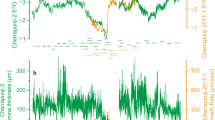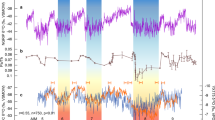Abstract
Models and palaeoclimate data suggest that the tropical Pacific climate system plays a key part in the mechanisms underlying orbital-scale and abrupt climate change1,2,3,4,5,6,7. Atmospheric convection over the western tropical Pacific is a major source of heat and moisture to extratropical regions, and may therefore influence the global climate response to a variety of forcing factors. The response of tropical Pacific convection to changes in global climate boundary conditions, abrupt climate changes and radiative forcing remains uncertain, however. Here we present three absolutely dated oxygen isotope records from stalagmites in northern Borneo that reflect changes in west Pacific warm pool hydrology over the past 27,000 years. Our results suggest that convection over the western tropical Pacific weakened 18,000–20,000 years ago, as tropical Pacific2,5,6,8 and Antarctic9 temperatures began to rise during the early stages of deglaciation. Convective activity, as inferred from oxygen isotopes, reached a minimum during Heinrich event 1 (ref. 10), when the Atlantic meridional overturning circulation was weak11, pointing to feedbacks between the strength of the overturning circulation and tropical Pacific hydrology. There is no evidence of the Younger Dryas event12 in the stalagmite records, however, suggesting that different mechanisms operated during these two abrupt deglacial climate events. During the Holocene epoch, convective activity appears to track changes in spring and autumn insolation, highlighting the sensitivity of tropical Pacific convection to external radiative forcing. Together, these findings demonstrate that the tropical Pacific hydrological cycle is sensitive to high-latitude climate processes in both hemispheres, as well as to external radiative forcing, and that it may have a central role in abrupt climate change events.
This is a preview of subscription content, access via your institution
Access options
Subscribe to this journal
Receive 51 print issues and online access
$199.00 per year
only $3.90 per issue
Buy this article
- Purchase on Springer Link
- Instant access to full article PDF
Prices may be subject to local taxes which are calculated during checkout



Similar content being viewed by others
References
Bush, A. B. G. & Philander, S. G. H. The role of ocean-atmosphere interactions in tropical cooling during the last glacial maximum. Science 279, 1341–1344 (1998)
Lea, D. W., Pak, D. K. & Spero, H. J. Climate impact of late quaternary equatorial Pacific sea surface temperature variations. Science 289, 1719–1724 (2000)
Clement, A. C., Cane, M. A. & Seager, R. An orbitally driven tropical source for abrupt climate change. J. Clim. 14, 2369–2375 (2001)
Koutavas, A., Lynch-Stieglitz, J., Marchitto, T. M. & Sachs, J. P. El Nino-like pattern in ice age tropical Pacific sea surface temperature. Science 297, 226–230 (2002)
Stott, L., Poulsen, C., Lund, S. & Thunell, R. Super ENSO and global climate oscillations at millennial time scales. Science 297, 222–226 (2002)
Rosenthal, Y., Oppo, D. W. & Linsley, B. K. The amplitude and phasing of climate change during the last deglaciation in the Sulu Sea, western equatorial Pacific. Geophys. Res. Lett. 30 doi: 10.1029/2002GL016612 (2003)
Kienast, M. et al. Eastern Pacific cooling and Atlantic overturning circulation during the last deglaciation. Nature 443, 846–849 (2006)
Visser, K., Thunell, R. & Stott, L. Magnitude and timing of temperature change in the Indo-Pacific warm pool during deglaciation. Nature 421, 152–155 (2003)
EPICA Community Members. One-to-one coupling of glacial climate variability in Greenland and Antarctica. Nature 444, 195–198 (2006)
Hemming, S. R. Heinrich events: Massive late Pleistocene detritus layers of the North Atlantic and their global climate imprint. Rev. Geophys. 42 doi: 10.1029/2003RG000128 (2004)
McManus, J. F., Francois, R., Gherardi, J. M., Keigwin, L. D. & Brown-Leger, S. Collapse and rapid resumption of Atlantic meridional circulation linked to deglacial climate changes. Nature 428, 834–837 (2004)
Rasmussen, S. O. et al. A new Greenland ice core chronology for the last glacial termination. J. Geophys. Res. 111 doi: 10.1029/2005JD006079 (2006)
Peterson, L. C., Haug, G. H., Hughen, K. A. & Rohl, U. Rapid changes in the hydrologic cycle of the tropical Atlantic during the last glacial. Science 290, 1947–1951 (2000)
Chiang, J. C. H. & Bitz, C. M. Influence of high latitude ice cover on the marine Intertropical Convergence Zone. Clim. Dyn. 25, 477–496 (2005)
Zhang, R. & Delworth, T. L. Simulated tropical response to a substantial weakening of the Atlantic thermohaline circulation. J. Clim. 18, 1853–1860 (2005)
Cobb, K. M., Adkins, J. F., Partin, J. W. & Clark, B. Regional-scale climate influences on temporal variations of rainwater and cave dripwater oxygen isotopes in northern Borneo. Earth Planet. Sci. Lett. (in the press)
Dansgaard, W. Stable isotopes in precipitation. Tellus 16, 436–468 (1964)
Rozanski, K., Araguas-Araguas, L. & Gonfiantini, R. in Climate Change in Continental Isotopic Records (eds Swart, P. K., Lohmann, K. C., McKenzie, J. & Savin, S.) 1–36 (Geophysical Monograph 78, American Geophysical Union, Washington DC, 1993)
Hendy, C. H. Isotopic geochemistry of speleothems. 1. Calculation of effects of different modes of formation on isotopic composition of speleothems and their applicability as palaeoclimatic indicators. Geochim. Cosmochim. Acta 35, 801–824 (1971)
Schrag, D. P. et al. The oxygen isotopic composition of seawater during the Last Glacial Maximum. Quat. Sci. Rev. 21, 331–342 (2002)
Steinke, S. et al. On the influence of sea level and monsoon climate on the southern South China Sea freshwater budget over the last 22,000 years. Quat. Sci. Rev. 25, 1475–1488 (2006)
Wang, Y. J. et al. A high-resolution absolute-dated Late Pleistocene monsoon record from Hulu Cave, China. Science 294, 2345–2348 (2001)
Kienast, M., Steinke, S., Stattegger, K. & Calvert, S. E. Synchronous tropical South China Sea SST change and Greenland warming during deglaciation. Science 291, 2132–2134 (2001)
Stott, L. et al. Decline of surface temperature and salinity in the western tropical Pacific Ocean in the Holocene epoch. Nature 431, 56–59 (2004)
Haug, G. H., Hughen, K. A., Sigman, D. M., Peterson, L. C. & Rohl, U. Southward migration of the intertropical convergence zone through the Holocene. Science 293, 1304–1308 (2001)
Fleitmann, D. et al. Holocene forcing of the Indian monsoon recorded in a stalagmite from Southern Oman. Science 300, 1737–1739 (2003)
Wang, X. et al. Interhemispheric anti-phasing of rainfall during the last glacial period. Quat. Sci. Rev. 25, 3391–3403 (2006)
Clement, A. C., Seager, R. & Cane, M. A. Orbital controls on the El Nino/Southern Oscillation and the tropical climate. Paleoceanography 14, 441–456 (1999)
Chappellaz, J. et al. Changes in the atmospheric CH4 gradient between Greenland and Antarctica during the Holocene. J. Geophys. Res. Atmos. 102, 15987–15997 (1997)
Dlugokencky, E. J., Walter, B. P., Masarie, K. A., Lang, P. M. & Kasischke, E. S. Measurements of an anomalous global methane increase during 1998. Geophys. Res. Lett. 28, 499–502 (2001)
Xie, P. P. & Arkin, P. A. Global precipitation: A 17-year monthly analysis based on gauge observations, satellite estimates, and numerical model outputs. Bull. Am. Meteorol. Soc. 78, 2539–2558 (1997)
Edwards, R. L., Chen, J. H., Ku, T. L. & Wasserburg, G. J. Precise timing of the last interglacial period from mass-spectrometric determination of Th-230 in corals. Science 236, 1547–1553 (1987)
Richards, D. A. & Dorale, J. A. in Uranium-Series Geochemistry (eds Bourdon, B., Henderson, G. M., Lundstrom, C. C. & Turner, S. P.) 407–460 (Reviews in Mineralogy & Geochemistry Vol. 52, Mineralogical Society of America, Chantilly, Virginia, 2003)
Robinson, L. F., Henderson, G. M. & Slowey, N. C. U-Th dating of marine isotope stage 7 in Bahamas slope sediments. Earth Planet. Sci. Lett. 196, 175–187 (2002)
Edwards, R. L., Chen, J. H. & Wasserburg, G. J. 238U–234U–230Th–232Th systematics and the precise measurement of time over the past 500,000 years. Earth Planet. Sci. Lett. 81, 175–192 (1987)
Acknowledgements
We thank J. Malang, J. Gau and S. Clark of Gunung Mulu National Park and J. Baei Hassan of Logan Bunut National Park for field assistance. J. Despain, G. Prest, S. Fryer, J. Mosenfelder and B. Hacker provided field assistance during the 2003 field trip. A. A. Tuen (UNIMAS) greatly facilitated our 2006 fieldwork in Sarawak. We also thank D. Lund for assistance in U–Th dating, and J. Lynch-Stieglitz and M. Schmidt for providing comments on early versions of the manuscript. The research was funded by NSF-ESH and by a Comer Abrupt Climate Change Fellowship.
The stalagmite δ18O data can be downloaded at http://www.ncdc.noaa.gov/paleo/pubs/partin2007/partin2007.html.
Author information
Authors and Affiliations
Corresponding author
Ethics declarations
Competing interests
Reprints and permissions information is available at www.nature.com/reprints. The authors declare no competing financial interests.
Supplementary information
Supplementary Information
The file contains Supplementary Methods; Supplementary Figures S1-S10 with Legends and Supplementary Tables S1-S2. The supplementary information contains detailed data for the age model calculations. Included with the age models are multiple isochrons for each stalagmite used to determine initial 230Th/232Th ratios. Also included are Hendy test data for all three stalagmites. (PDF 3300 kb)
Rights and permissions
About this article
Cite this article
Partin, J., Cobb, K., Adkins, J. et al. Millennial-scale trends in west Pacific warm pool hydrology since the Last Glacial Maximum. Nature 449, 452–455 (2007). https://doi.org/10.1038/nature06164
Received:
Accepted:
Issue Date:
DOI: https://doi.org/10.1038/nature06164
This article is cited by
-
Late Pleistocene island weathering and precipitation in the Western Pacific Warm Pool
npj Climate and Atmospheric Science (2024)
-
Multi-proxy validation of glacial-interglacial rainfall variations in southwest Sulawesi
Communications Earth & Environment (2023)
-
Kalimantan hydroclimate variability since the last glacial period
International Journal of Earth Sciences (2023)
-
Mechanisms and impacts of enhanced rainfall over large islands in the Maritime Continent during the mid-holocene
Climate Dynamics (2023)
-
Global precipitation change during the Holocene: a combination of records and simulations
Frontiers of Earth Science (2023)
Comments
By submitting a comment you agree to abide by our Terms and Community Guidelines. If you find something abusive or that does not comply with our terms or guidelines please flag it as inappropriate.



